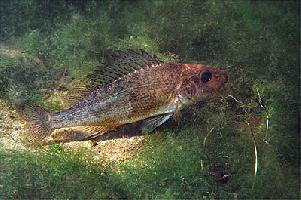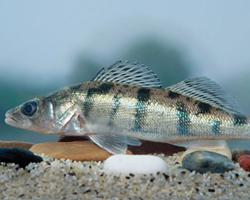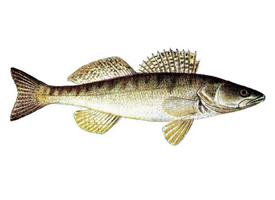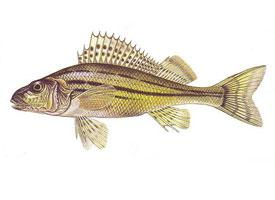
Poids et mesures
| Longueur | 25 cm |
|---|---|
| Poids | 0,3 kg |
Données biologiques
| Durée de vie | 11 r |
|---|
Description de l'animal
The Ruffe, scientifically known as Gymnocephalus cernuus, is a small yet fascinating freshwater fish native to Eurasia, from the British Isles across Europe and into Asia. This species belongs to the Percidae family, which also includes perch and darters. Despite its relatively diminutive size, with adults typically measuring between 18 to 25 cm in length, the Ruffe possesses a number of intriguing characteristics that distinguish it from other freshwater fishes.The Ruffe has a slender, elongated body, somewhat compressed laterally, which aids in its agility and speed within the water. Its skin is covered in small, rough scales that give the fish a slightly abrasive texture, a feature that has contributed to its common name. The coloration of the Ruffe is another point of interest; it displays a mottled pattern of dark browns and greens across its back, transitioning to lighter shades and eventually to a pale, almost white belly. This camouflaging coloration helps it to blend into the muddy or sandy bottoms of lakes, rivers, and estuaries where it prefers to dwell.
One of the most distinctive features of the Ruffe is its dorsal fin, which is actually split into two. The first dorsal fin is spiny and somewhat resembles that of a freshwater perch, while the second is softer and more ray-like. This dual-fin arrangement is not just for show; it provides the Ruffe with added stability and maneuverability as it navigates through its aquatic environment.
The Ruffe is an opportunistic feeder, primarily nocturnal, preying on a variety of food sources. Its diet consists mainly of invertebrates such as insect larvae, crustaceans, and small mollusks, but it will also consume fish eggs and even small fish if the opportunity arises. Its broad diet, combined with a high reproductive rate, where females can lay tens of thousands of eggs each season, has enabled the Ruffe to become a successful and sometimes invasive species in new environments.
Despite its small size, the Ruffe has had a significant impact on ecosystems into which it has been introduced, often outcompeting native species for food and habitat. Its introduction into North American waters, particularly the Great Lakes, has raised concerns about the ecological balance and the health of native fish populations.
In terms of behavior, the Ruffe is known to be a hardy and adaptable fish, capable of thriving in a range of environmental conditions. It prefers habitats with soft substrates like sand or mud where it can forage for food, and it is known to tolerate brackish waters, making it a common sight in estuaries as well as freshwater systems.
In summary, the Ruffe (Gymnocephalus cernuus) is a small, yet ecologically significant freshwater fish with a broad native range in Eurasia. Its distinctive physical characteristics, dietary flexibility, and reproductive capacity have allowed it to thrive in a variety of aquatic environments, although its success has also led to challenges in regions where it has been introduced. Despite its size, the Ruffe plays a complex role in its ecosystem, demonstrating the interconnectedness of aquatic habitats and the species that inhabit them.
Animaux similaires
Nouvelles photos d'animaux
Top 10 des animaux
- Dolphin gull (Leucophaeus scoresbii)
- Japanese macaque (Macaca fuscata)
- Stone loach (Barbatula barbatula)
- Greek tortoise (Testudo graeca)
- Russian tortoise (Testudo horsfieldii)
- Galápagos tortoise (Geochelone nigra complex)
- Diana monkey (Cercopithecus diana)
- Moustached guenon (Cercopithecus cephus)
- Common flying dragon (Draco volans)
- Galápagos penguin (Spheniscus mendiculus)


